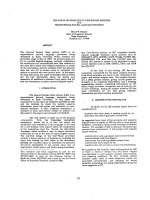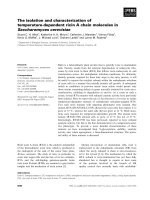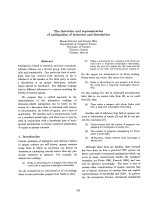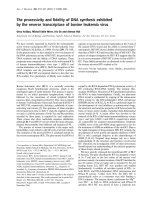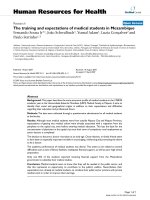báo cáo hóa học:" The HIV-1 Non-subtype B Workgroup: An International Collaboration for the Collection and Analysis of HIV-1 Non-subtype B Data" pot
Bạn đang xem bản rút gọn của tài liệu. Xem và tải ngay bản đầy đủ của tài liệu tại đây (183.29 KB, 3 trang )
BioMed Central
Page 1 of 3
(page number not for citation purposes)
Journal of the International AIDS Society
Open Access
Commentary
The HIV-1 Non-subtype B Workgroup: An International
Collaboration for the Collection and Analysis of HIV-1 Non-subtype
B Data
Rami Kantor*
1
, Robert W Shafer
2
, David Katzenstein
3
for the HIV-1 Non-
subtype B Workgroup*
Address:
1
Assistant Professor (Research), Division of Infectious Diseases, Brown University, Providence, Rhode Island,
2
Assistant Professor,
Division of Infectious Diseases, Stanford University, Stanford, California and
3
Professor, Division of Infectious Diseases, Stanford University,
Stanford, California
* Corresponding author
HIV Diversity and Drug Resistance
HIV-1 group M, the major pathogen responsible for the
AIDS pandemic, is characterized by a wide range of
genetic diversity among distinct subtypes (A-K), sub-sub-
types (A1, A2; F1, F2), and circulating recombinant forms
(CRF01_AE, CRF02_AG, and more). The different variants
are approximately equidistantly related, and are distinct
from one another across the entire genome.[1]
Current FDA-approved antiretroviral medications include
18 drugs targeted against 2 pol gene enzymes, the reverse
transcriptase (RT) and the protease. Antiretroviral drug
resistance is common as treatment efforts intensify, and is
both a cause and a result of virologic treatment failure and
incomplete virus suppression. Drug resistance is an adap-
tive viral response, and once virologic failure occurs, it is
necessary to change drug therapy, substituting to new
drugs to which the virus is susceptible for suppression of
virus replication. The larger body of experience with treat-
ment of subtype B virus infection has provided considera-
ble data on the patterns of resistance which may emerge
following virologic failure.[2]
The Global Paradox
Most of our current knowledge of HIV-1 drug susceptibil-
ity and resistance, and interpretations of genotypic
changes in HIV-1 RT and protease, are based on data
obtained from HIV-1 subtype B viruses prevalent in North
America, Western Europe, and Australia. Worldwide,
however, the majority of people with HIV are infected
with non-B subtypes, which differ from subtype B by as
much as 30% in env and 15% in pol.[3] With growing
treatment and access to antiretroviral therapy in resource-
limited settings, the non-subtype B viruses prevalent in
the African and Asian epidemics are only now becoming
the targets of widespread antiretroviral therapy. As the epi-
demic and treatment efforts mature, there is the expecta-
tion that differences in resistance patterns may emerge
between divergent subtypes.
There is extensive literature on sequence data from
untreated and treated persons infected with subtype B
virus. This has led to increasingly accurate, albeit complex,
interpretations of subtype B drug resistance. Patterns of
mutations arising during virologic failure with specific
drugs have become increasingly recognizable, making it
possible to improve the response to second-line treatment
through genotypic resistance testing.[4] However, the data
to accurately interpret resistance are generally not availa-
ble for non-B subtypes, and frequency and patterns of spe-
cific mutations and response to antiretroviral drug
therapies have not been well characterized.
For persons initiating drug therapy, the presence of
known drug-resistance mutations and polymorphic resi-
dues that differ from the consensus sequence of subtype B
may drive treatment response. For persons failing drug
therapy, as in subtype B, assessment of the drugs to which
their virus is susceptible may improve subsequent treat-
ment. Through clinical trials and practice, there are
Published: 23 February 2005
Journal of the International AIDS Society 2005, 7:71
This article is available from: />Journal of the International AIDS Society 2005, 7:71 />Page 2 of 3
(page number not for citation purposes)
increasing data on the genotype of B and non-B viruses
among drug-naive and -experienced patients. Although
the overall response to drugs appears to be similar, differ-
ences between subtypes in terms of specific mutations and
drug resistance may emerge as antiretrovirals are widely
applied to treatment throughout the world.
Potential Implications of HIV Diversity
Despite intensive studies, it has been difficult to identify
clear differences between the group M subtypes and CRFs
with respect to pathogenesis, transmission, or drug sus-
ceptibility. Host genetics, which include chemokine
receptor polymorphisms, pharmacogenomic markers,
and immune response diversity (HLA), each contribute to
the natural history and response to treatment within an
individual. In general, subtype B and non-B treated
patients have shown relatively similar rates of overall
response to drug treatment.[5,6] However, the pol genes of
each subtype are phylogenetically distinct, contain dis-
tinct amino acids at variable sites, and may use different
nucleic acid triplets, even to encode the same amino
acid.[7-9]
Protease and RT variation between subtypes is increas-
ingly linked to differences in disease progression and the
potential for infection transmission. Such differences also
affect enzymatic properties of protease and RT, pheno-
typic susceptibility to antiretroviral drugs, and evolution
of subtype-specific genotypic patterns of drug resistance.
Despite subtle differences that have been identified in
small cohorts, the response to antiretroviral therapy
among non-B infected persons is adequate and certainly
comparable to subtype B infected persons. Several
groups[10-13] have described the likely effect of specific
mutations on antiretroviral susceptibility in subtype B
viruses. Although this will support increased global access
to antiretroviral therapy, it is not known how well these
known subtype B mutations encompass resistance in non-
subtype B viruses. As treatment access is extended to
increasing numbers of individuals with non-subtype B
infection, the potential for inter-subtype differences in
drug response and drug resistance is enhanced. As knowl-
edge increases and new mutations are identified,[14]
algorithms to interpret drug resistance will need to be con-
tinuously updated.
The International Non-subtype B Workgroup
We have established an international workgroup for the
collection and analysis of RT and protease sequences and
data from persons infected with non-B HIV-1 subtypes.
Currently, the workgroup consists of investigators from
15 sites in 13 countries. The goal of the workgroup is to
collect and analyze a robust database of sequences and
clinical data to identify similarities and differences among
HIV-1 subtypes with respect to drug resistance. As treat-
ment efforts increase, data on non-B resistance patterns
will be useful to test the hypothesis that the knowledge
acquired in subtype B can be implemented in persons
infected with non-B subtypes.[15] The collected data are
intended to be publicly available, and can serve as a refer-
ence dataset and as a watch list for resistance surveillance
programs and epidemiologic studies (see poster
MoPeC3446 from the 15th International AIDS Confer-
ence).
Conclusion
Thousands of well-characterized sequences within each
subtype will likely be required for definitive conclusions
regarding different resistance patterns and clinical
response among non-B HIV-1. For new drugs and certain
combinations, there are insufficient data, even in subtype
B HIV-1. Worldwide collaboration, using common data
collection instruments and uniform protocols, is essential
to the analysis of non-B resistance. This is crucial as access
to antiretroviral therapy in the developing world increases
within the next few years, and as migration and travel lead
to a rise in non-B infected persons in the developed world.
Extensive interlaboratory collaboration will enable better
understanding of the potential implications of HIV-1
diversity and effective antiretroviral treatment.
Authors and Disclosures
Rami Kantor, MD, has disclosed no significant financial
interests or relationships.
Robert W. Shafer, MD, has disclosed no significant finan-
cial interests or relationships.
David Katzenstein, MD, has disclosed no significant
financial interests or relationships.
References
1. Robertson DL, Anderson JP, Bradac JA, et al.: HIV-1 Nomencla-
ture Proposal: A Reference Guide to HIV-1 Classification.
Human Retroviruses and AIDS: A Compilation and Analysis of Nucleic and
Amino Acid Sequences 2000:492-505 [ />hiv-db/COMPENDIUM/1999/6/nomenclature.pdf]. Los Alamos, NM:
Los Alamos National Laboratory Accessed February 3, 2005
2. Clavel F, Hance AJ: HIV drug resistance. N Engl J Med 2004,
350:1023-1035. Abstract
3. Osmanov S, Pattou C, Walker N, Schwardlander B, Esparza J: Esti-
mated global distribution and regional spread of HIV-1
genetic subtypes in the year 2000. J Acquir Immune Defic Syndr
2002, 29:184-190. Abstract
4. Ravela J, Betts BJ, Brun-Vezinet F, et al.: HIV-1 protease and
reverse transcriptase mutation patterns responsible for dis-
cordances between genotypic drug resistance interpretation
algorithms. J Acquir Immune Defic Syndr 2003, 33:8-14. Abstract
5. Weidle PJ, Malamba S, Mwebaze R, et al.: Assessment of a pilot
antiretroviral drug therapy programme in Uganda: patients'
response, survival, and drug resistance. Lancet 2002,
360:34-40. Abstract
6. Pillay D, Walker AS, Gibb DM, et al.: Impact of Human Immuno-
deficiency Virus Type 1 Subtypes on Virologic Response and
Emergence of Drug Resistance among Children in the Pae-
diatric European Network for Treatment of AIDS (PENTA)
5 Trial. J Infect Dis 2002, 186:617-625. Abstract
Publish with BioMed Central and every
scientist can read your work free of charge
"BioMed Central will be the most significant development for
disseminating the results of biomedical research in our lifetime."
Sir Paul Nurse, Cancer Research UK
Your research papers will be:
available free of charge to the entire biomedical community
peer reviewed and published immediately upon acceptance
cited in PubMed and archived on PubMed Central
yours — you keep the copyright
Submit your manuscript here:
/>BioMedcentral
Journal of the International AIDS Society 2005, 7:71 />Page 3 of 3
(page number not for citation purposes)
7. Kantor R, Katzenstein D, Camacho R, et al.: Genotypic analyses of
RT and protease sequences from persons infected with non-
subtype B HIV-1. Program and abstracts of the 10th Conference on
Retroviruses and Opportunistic Infections; February 1014, 2003; Boston,
Massachusetts . Abstract 623
8. Dumans AT, Soares MA, Machado ES, et al.: Synonymous genetic
polymorphisms within Brazilian human immunodeficiency
virus Type 1 subtypes may influence mutational routes to
drug resistance. J Infect Dis 2004, 189:1232-1238. Abstract
9. Kantor R, Carvalho AP, Wynhoven B, et al.: Nucleic acid differ-
ences between HIV-1 non-B and B reverse transcriptase and
protease sequences at drug resistance positions. Antivir Ther
2003, 8:S58.
10. D'Aquila RT, Schapiro JM, Brun-Vezinet F, et al.: Drug resistance
mutations in HIV-1. Top HIV Med 2003, 11:92-96. Abstract
11. Shafer RW, Jung DR, Betts BJ: Human immunodeficiency virus
type 1 reverse transcriptase and protease mutation search
engine for queries. Nat Med 2000, 6:1290-1292. Abstract
12. Van Laethem K, De Luca A, Antinori A, Cingolani A, Perna CF, Van-
damme AM: A genotypic drug resistance interpretation algo-
rithm that significantly predicts therapy response in HIV-1-
infected patients. Antivir Ther 2002, 7:123-129. Abstract
13. Meynard JL, Vray M, Morand-Joubert L, et al.: Phenotypic or geno-
typic resistance testing for choosing antiretroviral therapy
after treatment failure: a randomized trial. AIDS 2002,
16:727-736. Abstract
14. Brenner B, Turner D, Oliveira M, et al.: A V106M mutation in
HIV-1 clade C viruses exposed to efavirenz confers cross-
resistance to non-nucleoside reverse transcriptase inhibi-
tors. AIDS 2003, 17:F1-F5. Abstract
15. Kantor R, Shafer RW, Efron B, et al.: HIV-1 subtype-related differ-
ences in genotypic evolution: analysis of subtypes B and C
reverse transcriptase and protease sequences. Program and
abstracts of the 11th Conference on Retroviruses and Opportunistic Infec-
tions; February 811, 2004; San Francisco, California . Abstract 59


